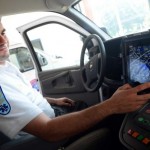New ambulance much more than a vehicle
John Burgeson, CT Post
Updated 8:30 pm, Saturday, September 14, 2013
STRATFORD — The’s a new ambulance in the apparatus bay of Stratford EMS, but it’s the raft of new electronics gear that has the emergency medical staff talking.
For starters, there’s a new defibrillator. We’ve all seen these things in action on TV medical dramas, and they’re seen hanging on walls in public places everywhere you go.
The new ones do much more than shock the heart to get it going. Called the LifePak 15, it provides a full picture in graph form of the patient: blood oxygen level, carbon dioxide level, heart rate, blood pressure and body temperature, as well as providing electrocardiogram graphs. Each one costs about $30,000 and six were purchased.
This is an addition to the usual defibrillation function, and EMS staffers are being trained on them this month, according to EMS Director Michael A. Loiz.
“It provides a full picture of what’s going on inside your heart, and exactly what kind of heart attack you’re having,” Loiz said. “All the information that they get from a patient in the ER.”
He said that there are different types of heart attacks, so with the new equipment, treatment in the field can be more accurately tailored to the patient.
“By the time we get to the hospital, they know exactly what’s going on with the patient and whisk the patient right up to the ER, because they’re already getting all of this information while we’re still in the field,” he said.
Then there’s a hoop-shaped Lucas CPR machine that delivers near-perfect chest compressions for as long as they’re needed.
“It does a better job than any human being could,” Loiz said. “Services that are using them see a huge increase in cardiac-arrest saves. It’s just way better CPR than any human is capable of.”
It’s not cheap. Each Lucas unit costs $15,000, but as Loiz notes, if it saves one life, it’s worth it. Stratford EMS handles about 50 chest-pain calls a month. Right now, the town has one of them; it’s hoped that more will be added soon.
“And since it handles the chest compressions, I can handle other issues with the patient while it’s operating,” he said.
The system got a grant to pay for both the Lucas and the LifePak units, Loiz said.
These new devices are useless if the ambulance winds up on the wrong street, which is where another new bit of gear comes in — the iPad Mobile Data Terminal, or MDT.
The iPad units are relatively cheap, about $700 each, and there are 10 of them in the service, or one for each vehicle.
A quick glance at the screen tells EMTs where to go, what to expect when they get there and what other emergency vehicles are doing in town.
“In green you see all the ambulances, and in red you see the fire apparatus, in real time,” said paramedic and operations supervisor Kevin Giasullo. “The real cool feature is the mapping feature. It’s tied into Apple Maps, and we can also get a picture of the building we’re going to, too.”
Giasullo said that the iPads replace the far more costly and bulky laptop computers. These were purchased as part of the town’s computer-aided dispatch, or CAD, effort for its emergency services.
“And they also can do much more,” he said. “It’s a two-way communications tool with the dispatcher — as she’s typing in the information. It’ll tell whether or not it’s a hot call, too.”
The new ambulance, called “805,” isn’t entirely new; the box, or the patient compartment, is from an ambulance the town purchased in 2005 and which has been mounted on a new Chevrolet chassis.
“It’s a re-mount,” said Loiz. “The box usually is not all that bad off — it’s the running gear that wears out. So by mounting the old box on a new chassis, I get what amounts to a new vehicle for $117,000, as opposed to $170,000.”
The cabinets were reconfigured so EMTs can grab supplies without reaching over the patient.
“If I have to lean over the patient to get something, and the vehicle is moving, I’m surfing,” he said, demonstrating. “Not safe.”
The new ambulance is one of six in the stable; there are another four “fly cars” that can get a paramedic to the scene, but can’t transport a patient.
Although the terms “EMT” and “paramedic” are tossed about with abandon on TV shows, a paramedic is licensed to perform far more advanced procedures such as administering drugs, performing tracheostomies and starting intravenous lines.
The fly cars can be used to move paramedics around from one emergency to another; in many situations, an EMT is all that’s needed.
“For example, we’ll get a call for a broken leg, which is a pretty basic event,” Loiz said. “But when we get there, we find that it’s a broken leg with heavy internal bleeding, so we’ll have to get a paramedic over there to start the IV.”
Loiz said that paramedics are routinely assigned to calls that involve chest pain.
As for paying for the ambulance, the EMS service paid for it without using town funds; the service charges patients who are transported.
“We’re entirely self-sufficient,” Loiz said.
So what happens when the iPads fail to boot up?
“We still have paper maps on board,” Giasullo said.
jburgeson@ctpost.com; 203-330-6403; http://twitter.com/johnburgeson



